 Romney Does Brownface?
Romney Does Brownface?
Problematic visual imagery continues to plague the Romney campaign. The most recent manifestation of this issue took the form of questions over whether Romney had tried to enhance his appeal to Hispanics by adding some bronzing fake tan to his face for a September 17 address to Los Angeles’ Hispanic Chamber of Commerce and a September 19 appearance on Univision, a Spanish-language television network in the United States. (See Sara Gates’s September 24 report in The Huffington Post.)
To paraphrase H. L. Mencken, no one ever went broke underestimating the intelligence of the Romney campaign. Yet I find this “Latin tinge” scenario improbable, despite the fact that, as images from the Univision interview indicate, Romney appeared even more dark-skinned that his two Latino interviewers, Maria Elena Salinas and Jorge Ramos, during a September 19, 2012 “Meet the Candidates” forum at Univision’s Miami studio.
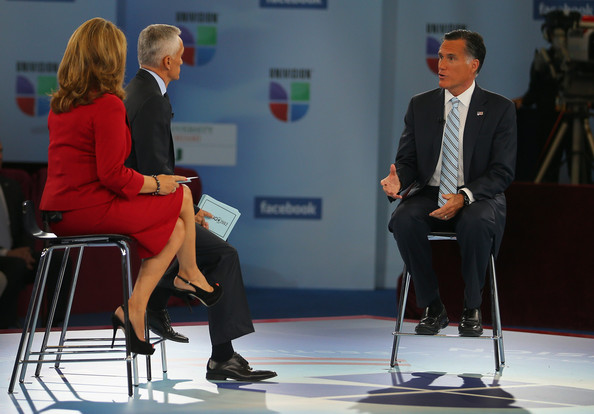
(L-R) Maria Elena Salinas, Jorge Ramos, Mitt Romney, Univision, September 19, 2012, screenshot.
According to another HuffPost story, “His makeup artist for the Univision appearance, Lazz Rodriguez, said, ‘It was definitely a real tan.'” Of course it’s possible that Lazz Masson Rodriguez has friends and/or relatives who are illegal immigrants, or are part of the 47 percent Romney despises; and he’s definitely among that component of the electorate whose potential commitment as a voting bloc to the Democratic Party Mitt Romney declared a threat to the United States. Not unthinkable that he slyly compromised Romney’s looks by applying a dubious shade of makeup. But Rodriguez has adamantly denied this, and I see no reason to doubt the word of a respected professional.
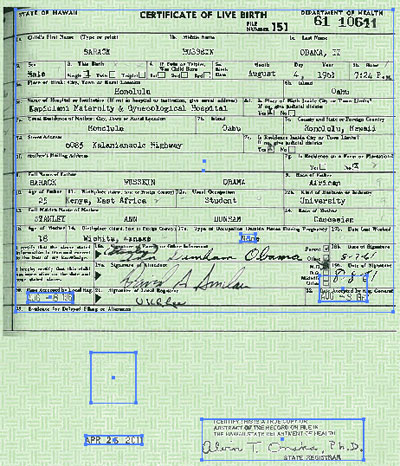
Barack Obama birth certificate with purported alterations, Infowars.com, April 28, 2011.
Did Romney bronze himself up? He definitely looks more tan in those screenshots than he does in images from the days before and after his Univision moment. And I’d put nothing past Romney and his posse. But here’s where the photo critic in me kicks in. Those images weren’t all made with the same combination of camera, lens, film and filter (or digital settings), under standardized or comparable lighting conditions. So I feel more inclined to chalk this up to the vagaries of TV makeup in combination with studio lighting than to either a desperate Romney campaign attempt to woo Hispanic voters or a malicious makeup artist’s subversion.
Yet this incident indicates the close scrutiny to which politicians now find themselves subject — especially, and not surprisingly, at the presidential level. From the pixel-level examination of Obama’s Hawaiian birth certificate by the loony right to this weighing of Romney’s relative hue, nothing escapes the watchful eye of the blogosphere. Which doesn’t make their conclusions correct.
Looking Presidential, Looking Citizenly
Photography has played a role in American electoral politics ever since February 27, 1860, when Mathew Brady made a portrait of Abraham Lincoln in New York City. After Lincoln won the election he said, “Brady and the Cooper Institute made me President.” (Lincoln delivered a stirring lecture at Cooper Union on Astor Place, the same day he stood for Brady’s study.)

Photoshopped composite of John Kerry and Jane Fonda, 2004.
Since then photographs have shaped the ways that the citizenry views politicians at all levels, from the local to the national. Photos of all kinds — private snapshots, formal portraits, press reportage, surveillance-camera images, doctored images — have affected the outcome of many elections. Think Gary Hart with Donna Rice on his lap, or John Kerry fictionally onstage with Jane Fonda during the Vietnam War.
So far, no fake photos, and no credible but incriminating ones, have emerged in the 2012 race. However, in addition to the stills and videos chronicling the current presidential election campaign, another kind of photographic image will play a key role in the 2012 election: the standard functional frontal color portrait, as it appears on one or another form of picture ID.
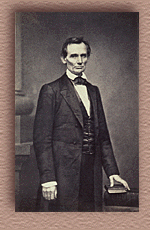
Mathew Brady, portrait of Abraham Lincoln, 1860.
The formal structure of this image constitutes a trope that I’ve discussed here at considerable length over the past several months. But the question at stake regarding the election doesn’t concern aesthetics, so let’s set those matters aside. Their importance pales before the fact that never before in our history as a nation — indeed, so far as I know, never before in human history — has the outcome of a planned contest for leadership hinged on the citizenry’s possession of specific documents bearing their likenesses (or lack thereof).
For those of you who’ve been Rip Van Winkling it, at the instigation of Republican politicians and Republican-dominated legislatures a number of states have passed laws requiring presentation of a government-issued picture ID at polling places on November 6, as a prerequisite for voting. They’ve concentrated these efforts on swing states where disqualifying those lacking such documents would predominantly disenfranchise poor people, minorities, students, the disabled, and the elderly — to wit, people statistically inclined to vote Democratic. They’ve been quite forthright about this; according to an ABC News report, “Republican House Majority Leader Mike Turzai made waves in June when he said at the Republican State Committee meeting that the voter ID law ‘is going to allow Governor Romney to win the state of Pennsylvania.'”
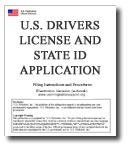
The forcing through of these laws in the middle of a presidential election year represents Republican trickery and voter fraud itself, since most of the people rendered unable to vote by these laws will be lawfully registered voters who have voted for years. In many states it represents a hardship for reasons having to do with the cost of obtaining the necessary documents required for acquisition of a picture ID, the time involved, the travel distances, the limited office hours of agencies providing such IDs, and in a few Catch-22 cases the absence of any such offices in affected voting districts. And the problem they claim to solve — voter fraud in the form of voter impersonation — occurs so infrequently as to be statistically negligible.
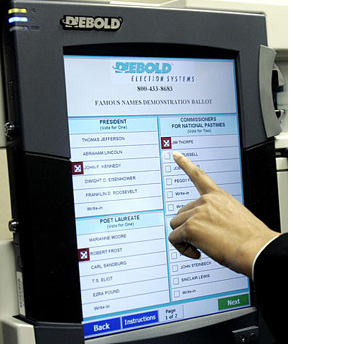
Diebold electronic voting machine, model HR811.
The greatest risk to the democratic ideal of “one person, one vote” is the Republic Party itself. Witness the manufacture of hackable “black box” electronic voting machines by Republican-owned companies such as Diebold, their omnipresence in swing states with Republican governors, the Florida ballot fraud of the Y2K election that gave the White House to Dubya, and now this spate of last-minute game-changing legislation by Republicans.
Most of these laws face challenge in the courts; a number of them have already been overturned. Possibly none of them will stand by Election Day. What impact they’ll have on the election we can’t yet forecast. Yet, even assuming that this won’t affect the 2012 election, it raises a question that merits nation-wide debate: Should everyone over a certain age have the ability to obtain a government-validated picture ID, and should he or she be required to produce it for designated purposes, including voting?
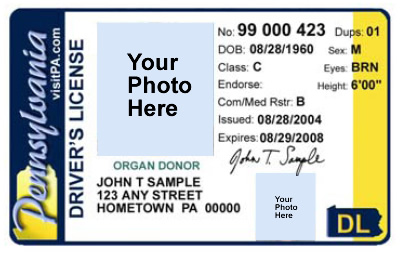 Let’s assume that the relevant government obligations would mandate making acquisition of such mandatory cards inexpensive (or even free) and logistically simple — through any post office, at any government building, from service buses making periodic scheduled visits to outlying districts. Do we have a problem with the picture ID as such?
Let’s assume that the relevant government obligations would mandate making acquisition of such mandatory cards inexpensive (or even free) and logistically simple — through any post office, at any government building, from service buses making periodic scheduled visits to outlying districts. Do we have a problem with the picture ID as such?
Looking in my own wallet, I find three that I carry at all times: my driver’s license, my New York senior citizen Metrocard, and my New York State senior benefits card. I have another current photo ID, my passport, tucked away. And I’ve had yet others, now expired, that accompanied adjunct-faculty teaching jobs and a stint as a doctoral-level student at New York University in the past.
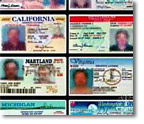 I don’t find the concept of a photo ID objectionable in itself. I’ve had a passport since my late teens, the first such ID I obtained. The transition to a photo ID driver’s license in New York State happened back in 1963, half a century ago; I’ve had one of those since 1964. Carrying that one, and the two senior cards, doesn’t inconvenience me in any way. To the contrary, they’ve come in handy for purposes ranging from obtaining my New York Public Library card to getting legal documents notarized. And I don’t consider that an intrusion into my privacy by the surveillance state; I’m free to leave them at home, after all.
I don’t find the concept of a photo ID objectionable in itself. I’ve had a passport since my late teens, the first such ID I obtained. The transition to a photo ID driver’s license in New York State happened back in 1963, half a century ago; I’ve had one of those since 1964. Carrying that one, and the two senior cards, doesn’t inconvenience me in any way. To the contrary, they’ve come in handy for purposes ranging from obtaining my New York Public Library card to getting legal documents notarized. And I don’t consider that an intrusion into my privacy by the surveillance state; I’m free to leave them at home, after all.
My polling place, where I’ve voted since 1967, uses a signature-verification system, but it wouldn’t disturb me if they asked for a photo ID instead. So I don’t object to the requirement in and of itself. In an age of rampant identity theft, it seems reasonable to ask citizens to obtain at least one piece of verifiable photo ID for use in certain situations, voting among them. But if that burden gets put on the citizenry, then the states must shoulder a corollary burden:
• Ensuring that the cost of such state-issued ID is reasonable, and reducing that fee (or eliminating it entirely) for those below a certain income level.
• Ensuring that the amount and types of documentation necessary to obtain such an ID are reasonable and broadly defined.
• Ensuring that obtaining such documentation involves only a quick trip by public transportation. This might necessitate state funding of registration vans that would tour various districts, be made available upon request by centers for the disabled and senior-citizens, etc.
• Ensuring that the citizenry has sufficient time to participate in such programs by initiating registration programs involving all of the above, defining a realistic transition period, creating systems of multiple verification before purging anyone from the voter rolls, etc.
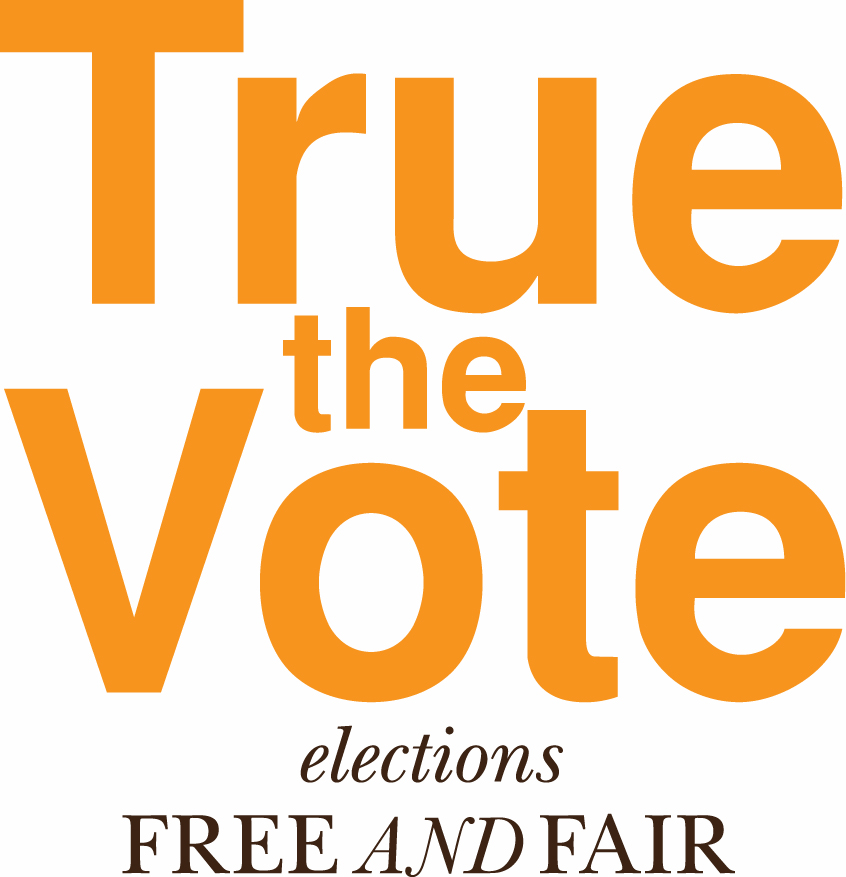
No Republicans anywhere have proposed any of the above efforts, clear evidence that the intent of their legislation (and of such extra-legal actions as the “True the Vote” vigilante patrols) is intimidation of voters likely to cast their ballots for Democrats. Fighting those efforts while encouraging not only maximum voter registration by eligible citizens but also the obtaining of the types of documentation needed for full participation in contemporary civic, social, and economic life in the 21st century — which certainly includes one or more photo IDs — makes sense on every level.
Randy Newman Chimes In
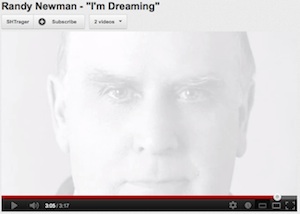
Randy Newman, “I’m Dreaming” video, screenshot.
Randy Newman has added his two cents’ worth to the campaign by issuing a new song, “I’m Dreaming,” in which he adopts the persona of an angry middle-aged white man who wants a white man in the White House — a mellow Archie Bunker, if you will. You can watch the video here, and download a free mp3 file of the song here.
Good for Newman for having his say, and sweet of him to offer this as a gift. But the song of his I hear in my head every time I see Mitt Romney, especially after his disparaging comments anent the moocher class, is the Newman classic Sail Away.
•
Correction: In the original version of this post I wrongly attributed to P. T. Barnum a paraphrased quote from H. L. Mencken.
•
For an index of links to all posts related to this story, click here.
•
This post supported by a donation from the Estate of Lyle Bongé.
Election 2012: Image World (4)
Problematic visual imagery continues to plague the Romney campaign. The most recent manifestation of this issue took the form of questions over whether Romney had tried to enhance his appeal to Hispanics by adding some bronzing fake tan to his face for a September 17 address to Los Angeles’ Hispanic Chamber of Commerce and a September 19 appearance on Univision, a Spanish-language television network in the United States. (See Sara Gates’s September 24 report in The Huffington Post.)
To paraphrase H. L. Mencken, no one ever went broke underestimating the intelligence of the Romney campaign. Yet I find this “Latin tinge” scenario improbable, despite the fact that, as images from the Univision interview indicate, Romney appeared even more dark-skinned that his two Latino interviewers, Maria Elena Salinas and Jorge Ramos, during a September 19, 2012 “Meet the Candidates” forum at Univision’s Miami studio.
(L-R) Maria Elena Salinas, Jorge Ramos, Mitt Romney, Univision, September 19, 2012, screenshot.
According to another HuffPost story, “His makeup artist for the Univision appearance, Lazz Rodriguez, said, ‘It was definitely a real tan.'” Of course it’s possible that Lazz Masson Rodriguez has friends and/or relatives who are illegal immigrants, or are part of the 47 percent Romney despises; and he’s definitely among that component of the electorate whose potential commitment as a voting bloc to the Democratic Party Mitt Romney declared a threat to the United States. Not unthinkable that he slyly compromised Romney’s looks by applying a dubious shade of makeup. But Rodriguez has adamantly denied this, and I see no reason to doubt the word of a respected professional.
Barack Obama birth certificate with purported alterations, Infowars.com, April 28, 2011.
Did Romney bronze himself up? He definitely looks more tan in those screenshots than he does in images from the days before and after his Univision moment. And I’d put nothing past Romney and his posse. But here’s where the photo critic in me kicks in. Those images weren’t all made with the same combination of camera, lens, film and filter (or digital settings), under standardized or comparable lighting conditions. So I feel more inclined to chalk this up to the vagaries of TV makeup in combination with studio lighting than to either a desperate Romney campaign attempt to woo Hispanic voters or a malicious makeup artist’s subversion.
Yet this incident indicates the close scrutiny to which politicians now find themselves subject — especially, and not surprisingly, at the presidential level. From the pixel-level examination of Obama’s Hawaiian birth certificate by the loony right to this weighing of Romney’s relative hue, nothing escapes the watchful eye of the blogosphere. Which doesn’t make their conclusions correct.
Looking Presidential, Looking Citizenly
Photography has played a role in American electoral politics ever since February 27, 1860, when Mathew Brady made a portrait of Abraham Lincoln in New York City. After Lincoln won the election he said, “Brady and the Cooper Institute made me President.” (Lincoln delivered a stirring lecture at Cooper Union on Astor Place, the same day he stood for Brady’s study.)
Photoshopped composite of John Kerry and Jane Fonda, 2004.
Since then photographs have shaped the ways that the citizenry views politicians at all levels, from the local to the national. Photos of all kinds — private snapshots, formal portraits, press reportage, surveillance-camera images, doctored images — have affected the outcome of many elections. Think Gary Hart with Donna Rice on his lap, or John Kerry fictionally onstage with Jane Fonda during the Vietnam War.
So far, no fake photos, and no credible but incriminating ones, have emerged in the 2012 race. However, in addition to the stills and videos chronicling the current presidential election campaign, another kind of photographic image will play a key role in the 2012 election: the standard functional frontal color portrait, as it appears on one or another form of picture ID.
Mathew Brady, portrait of Abraham Lincoln, 1860.
The formal structure of this image constitutes a trope that I’ve discussed here at considerable length over the past several months. But the question at stake regarding the election doesn’t concern aesthetics, so let’s set those matters aside. Their importance pales before the fact that never before in our history as a nation — indeed, so far as I know, never before in human history — has the outcome of a planned contest for leadership hinged on the citizenry’s possession of specific documents bearing their likenesses (or lack thereof).
For those of you who’ve been Rip Van Winkling it, at the instigation of Republican politicians and Republican-dominated legislatures a number of states have passed laws requiring presentation of a government-issued picture ID at polling places on November 6, as a prerequisite for voting. They’ve concentrated these efforts on swing states where disqualifying those lacking such documents would predominantly disenfranchise poor people, minorities, students, the disabled, and the elderly — to wit, people statistically inclined to vote Democratic. They’ve been quite forthright about this; according to an ABC News report, “Republican House Majority Leader Mike Turzai made waves in June when he said at the Republican State Committee meeting that the voter ID law ‘is going to allow Governor Romney to win the state of Pennsylvania.'”
The forcing through of these laws in the middle of a presidential election year represents Republican trickery and voter fraud itself, since most of the people rendered unable to vote by these laws will be lawfully registered voters who have voted for years. In many states it represents a hardship for reasons having to do with the cost of obtaining the necessary documents required for acquisition of a picture ID, the time involved, the travel distances, the limited office hours of agencies providing such IDs, and in a few Catch-22 cases the absence of any such offices in affected voting districts. And the problem they claim to solve — voter fraud in the form of voter impersonation — occurs so infrequently as to be statistically negligible.
Diebold electronic voting machine, model HR811.
The greatest risk to the democratic ideal of “one person, one vote” is the Republic Party itself. Witness the manufacture of hackable “black box” electronic voting machines by Republican-owned companies such as Diebold, their omnipresence in swing states with Republican governors, the Florida ballot fraud of the Y2K election that gave the White House to Dubya, and now this spate of last-minute game-changing legislation by Republicans.
Most of these laws face challenge in the courts; a number of them have already been overturned. Possibly none of them will stand by Election Day. What impact they’ll have on the election we can’t yet forecast. Yet, even assuming that this won’t affect the 2012 election, it raises a question that merits nation-wide debate: Should everyone over a certain age have the ability to obtain a government-validated picture ID, and should he or she be required to produce it for designated purposes, including voting?
Looking in my own wallet, I find three that I carry at all times: my driver’s license, my New York senior citizen Metrocard, and my New York State senior benefits card. I have another current photo ID, my passport, tucked away. And I’ve had yet others, now expired, that accompanied adjunct-faculty teaching jobs and a stint as a doctoral-level student at New York University in the past.
My polling place, where I’ve voted since 1967, uses a signature-verification system, but it wouldn’t disturb me if they asked for a photo ID instead. So I don’t object to the requirement in and of itself. In an age of rampant identity theft, it seems reasonable to ask citizens to obtain at least one piece of verifiable photo ID for use in certain situations, voting among them. But if that burden gets put on the citizenry, then the states must shoulder a corollary burden:
• Ensuring that the cost of such state-issued ID is reasonable, and reducing that fee (or eliminating it entirely) for those below a certain income level.
• Ensuring that the amount and types of documentation necessary to obtain such an ID are reasonable and broadly defined.
• Ensuring that obtaining such documentation involves only a quick trip by public transportation. This might necessitate state funding of registration vans that would tour various districts, be made available upon request by centers for the disabled and senior-citizens, etc.
• Ensuring that the citizenry has sufficient time to participate in such programs by initiating registration programs involving all of the above, defining a realistic transition period, creating systems of multiple verification before purging anyone from the voter rolls, etc.
No Republicans anywhere have proposed any of the above efforts, clear evidence that the intent of their legislation (and of such extra-legal actions as the “True the Vote” vigilante patrols) is intimidation of voters likely to cast their ballots for Democrats. Fighting those efforts while encouraging not only maximum voter registration by eligible citizens but also the obtaining of the types of documentation needed for full participation in contemporary civic, social, and economic life in the 21st century — which certainly includes one or more photo IDs — makes sense on every level.
Randy Newman Chimes In
Randy Newman, “I’m Dreaming” video, screenshot.
Randy Newman has added his two cents’ worth to the campaign by issuing a new song, “I’m Dreaming,” in which he adopts the persona of an angry middle-aged white man who wants a white man in the White House — a mellow Archie Bunker, if you will. You can watch the video here, and download a free mp3 file of the song here.
Good for Newman for having his say, and sweet of him to offer this as a gift. But the song of his I hear in my head every time I see Mitt Romney, especially after his disparaging comments anent the moocher class, is the Newman classic Sail Away.
•
Correction: In the original version of this post I wrongly attributed to P. T. Barnum a paraphrased quote from H. L. Mencken.
•
For an index of links to all posts related to this story, click here.
•
This post supported by a donation from the Estate of Lyle Bongé.